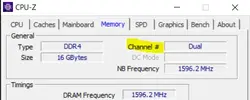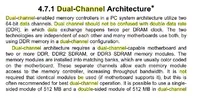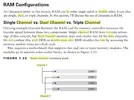Ottoore
Utente Èlite
- Messaggi
- 27,341
- Reazioni
- 13,706
- Punteggio
- 248
Qui però c'è scritto il contrario: https://en.wikiversity.org/wiki/Computer_Support/Hardware/RAM
E anche qui: https://www.gamersnexus.net/guides/1349-ram-how-dual-channel-works-vs-single-channel?showall=1
- A computer bus operating with double data rate (DDR) transfers data on both the rising and falling edges of the clock signal. DDR should not be confused with dual channel, in which each memory channel accesses two RAM modules simultaneously. The two technologies are independent of each other and many motherboards use both, by using DDR memory in a dual channel configuration.[5] Compared to single data rate (SDR) SDRAM, the DDR SDRAM interface makes higher transfer rates possible by more strict control of the timing of the electrical data and clock signals.[6]
The memory will sort of ping-pong data down the channels, effectively doubling its potential "speed." This should not be confused with double-datarate memory (DDR), which operates independent of the channel configuration.
Con tanto di immagini:
Visualizza allegato 352780
Visualizza allegato 352781
Il contrario di cosa?
Cpu-z riporta il single data rate: lo fa con un singolo modulo, con 2 moduli in single channel, con 2 moduli in dual channel, con 4 moduli in dual channel, con 4 moduli in quad channel etc.
Le 2 cose non vanno confuse indubbiamente.






